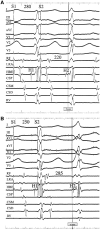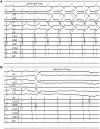Adenosine-sensitive decremental conduction over short non-decremental atrioventricular accessory pathways after radiofrequency ablation: case series
- PMID: 31020120
- PMCID: PMC6177018
- DOI: 10.1093/ehjcr/yty040
Adenosine-sensitive decremental conduction over short non-decremental atrioventricular accessory pathways after radiofrequency ablation: case series
Abstract
Introduction: Decremental conduction in short anterograde atrioventricular accessory pathways (AV-APs) is rare.
Case presentation: We report on two cases with radiofrequency (RF) ablation of anterograde fast non-decremental AV-AP conduction. In Case 1, electrophysiological testing revealed fast non-decremental conduction over an anterograde short right posteroseptal AV-AP. During ablation, latent pre-excitation due to anterograde adenosine-sensitive slow decremental conduction over the same AV-AP manifested after eliminating its non-decremental conduction. Complete abolition of AP conduction was achieved by additional ablation. In Case 2, overt pre-excitation disappeared after the first ablation session for an anterograde short non-decremental right mid-septal AV-AP. However, latent pre-excitation due to markedly decremental conduction over the same AV-AP unmasked by intravenous adenosine and atrial pacing manoeuvers could be eliminated in a second session.
Discussion: This report describes unusual anterograde short non-decremental AV-APs, developing markedly slow adenosine-sensitive decremental conduction during ablation. Such AV-AP conduction properties due to RF injury may be overlooked and mask incomplete ablation and point-out careful testing including stimulation techniques and low and higher dose adenosine administration post-ablation.
Keywords: Atrioventricular accessory pathway; Case series; Decremental conduction; Latent pre-excitation; Radiofrequency ablation; Wolff-Parkinson-White syndrome.
Figures







References
-
- Ticho BC, Saul PS, Hulse JE, De W, Lulu J, Walsh EP.. Variable location of accessory pathways associated with the permanent form of junctional reciprocating tachycardia and confirmation by radiofrequency ablation. Am J Cardiol 1992;70:1559–1564. - PubMed
-
- Gaita F, Haissaguerre M, Giustetto C, Fischer B, Riccardi R, Richiardi E, et al.Catheter ablation of permanent junctional reciprocating tachycardia with radiofrequency current. J Am Coll Cardiol 1995;25:648–654. - PubMed
-
- Haissaguerre M, Cauchemez B, Marcus F, Le Métayer P, Lauribe P, Poquet F, et al.Characteristics of the ventricular insertion sites of accessory pathways with anterograde decremental conduction properties. Circulation 1995;91:1077–1085. - PubMed
-
- Hluchy J, Schickel S, Schlegelmilch P, Jörger U, Brägelmann F, Sabin GV.. Decremental conduction properties in overt and concealed atrioventricular accessory pathways. Europace 2000;2:42–53. - PubMed
-
- Lerman BB, Greenberg M, Overholt ED, Swerdlow CD, Smith RT, Sellers TD, et al.Differential electrophysiologic properties of decremental retrograde pathways in long RP´ tachycardia. Circulation 1987;76:21–31. - PubMed
Publication types
LinkOut - more resources
Full Text Sources
Miscellaneous
